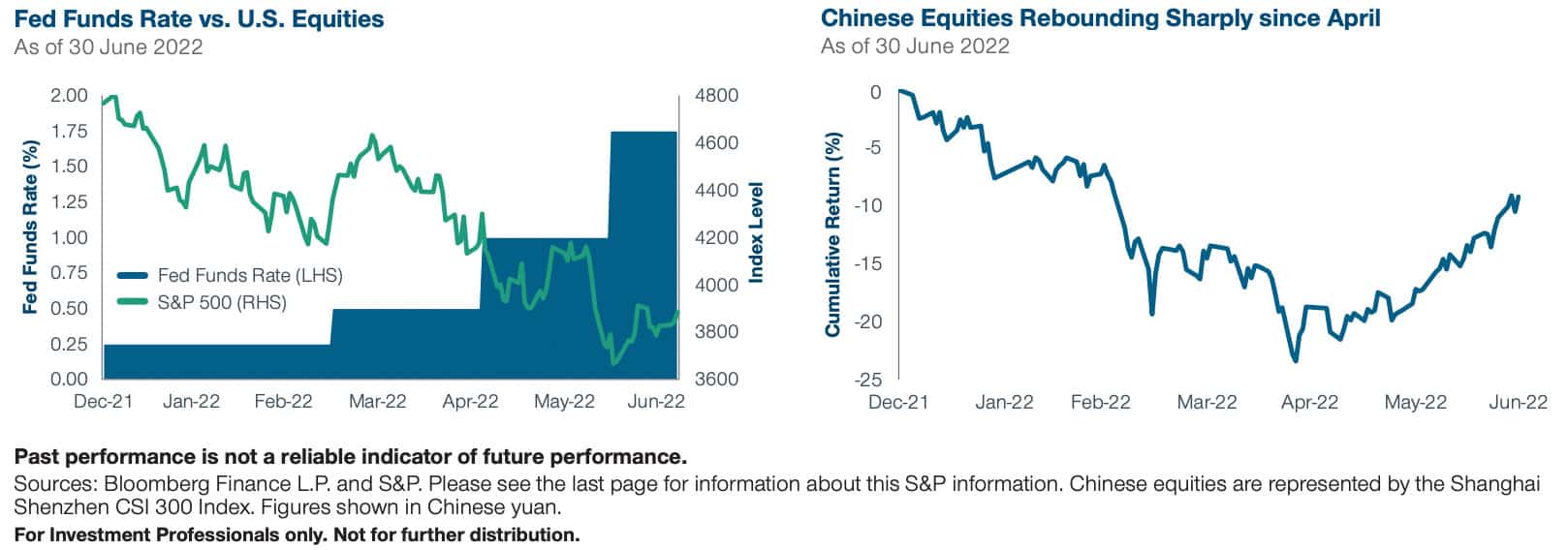
MARKET PERSPECTIVE
Inflation concerns remain at the forefront for central banks and investors as global growth continues to trend lower amid supply disruptions, geopolitical challenges and reduction of liquidity, setting the stage for a challenging macro backdrop.
- The U.S. Federal Reserve (Fed) remains committed to its tightening policy, hinting at a steady path forward to further combat inflation. The European Central Bank (ECB) has telegraphed its plan to end asset purchases and begin raising rates despite a fragile macro backdrop, while the Bank of Japan remains steadfast on its policy of yield curve control. The Reserve Bank of Australia (RBA) also warned of more rate hikes to come.
- While most emerging market (EM) central banks continue to tighten policy in response to heightened inflation and weak currencies, China policies remain supportive following the easing of pandemic-related lockdowns to help bolster growth.
- Key risks to global markets include central bank missteps, persistent inflation, impacts of the Russia-Ukraine conflict, potential for a sharper slowdown in global growth and China’s balance between containing COVID and growth.
MARKET THEMES
Kaput!
For the last several decades, the Fed has had the luxury of pursuing its dual mandate—maximum employment while maintaining price stability—amid anchored low inflation. Major shocks to the economy and markets, including the great financial crisis and outbreak of COVID, could be combatted with aggressive rate-cutting and trillions of dollars in quantitative easing with little fear of stoking inflation. This environment was beneficial for the Fed and investors who became complacent in expecting a Fed “put” would be there to provide a backstop when a crisis occurred. Unfortunately, the Fed’s aggressive easing this time around came alongside unprecedented fiscal stimulus, flooding consumers and corporations with cash and the release of pent-up demand colliding with severe supply shortages related to COVID lockdowns. Add in the energy and agricultural shortages tied to the Russia-Ukraine conflict and you have the perfect storm for runaway inflation. Unfortunately for the Fed, they can’t fix supply and will likely remain steadfast in tightening policy to combat inflation, even if it risks pushing the economy into recession—meaning for now that the Fed “put” is kaput.
Change of Tone
China’s stock market had fallen by nearly 24% towards the end of April this year as strict lockdowns related to the country’s zero-COVID policy weighed on the growth outlook. With evidence now showing COVID-19 infections are abating, lockdowns have been eased and inbound traveler quarantine requirements have been halved, allowing China’s economy to gradually reopen. This shift in sentiment comes at a time when the People’s Bank of China has pledged to maintain supportive monetary policy to aid the country’s recovery, with a cautious eye on stability
Recent statements from President Xi Jinping pledging government support for parts of the technology sector, citing their larger role in the economy’s future, also seemed to suggest an easing of regulatory crackdowns experienced last year. In a matter of months, the negative sentiment surrounding China has shifted to it being the “new bull market,” with Chinese stocks up close to 20% off April’s lows (see Note 1). While still early in reopening and with China’s economic data just starting to show signs of improvement, the tone inside and outside China suggests that the worst may be behind, at least for now.
PORTFOLIO POSITIONING
- Despite more attractive valuations following recent declines, we remain cautious on equities given more challenging earnings environment into slowing growth and tighter financial conditions. We remain underweight bonds and overweight cash.
- Within equities, we moderated Australian overweight and US underweight positions. Our decision was based on a weaker earnings outlook for Australia and growing recession risks impacting demand for commodities.
- We added to Global High Yield, funded from cash-like strategies, due to high yield’s attractive yield levels and our constructive outlook on its fundamentals.
- We also closed the underweight position in Australian bonds as RBA’s expected path of hiking is revised lower. This move was also funded from cash-like strategies.
Notes:
As of 15 July Chinese stocks were up 12% off April’s lows.
T. Rowe Price’s Australia Investment Committee, led by Thomas Poullaouec, Head of Multi-Asset Solutions APAC in Hong Kong, comprises local and global investment professionals who apply views from the firm’s Global Asset Allocation Committee to make informed asset allocation views from an Australian investor perspective.
From the T. Rowe Price Australia Investment Committee, as at 30 June 2022
Thomas Poullaouec, Head of Multi Asset Solutions APAC
Richard Coghlan, Multi Asset Portfolio Manager
Randal Jenneke, Head of Australian Equities
Wenting Shen, Multi-Asset Solutions Strategist
Scott Solomon, Associate Portfolio Manager, Fixed Income Division


































